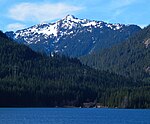Abiel Peak

Abiel Peak is a 5,365 ft (1,640 m) mountain summit located in eastern King County of Washington state. It is set 1,000 feet west of the crest of the Cascade Range, on land managed by Mount Baker-Snoqualmie National Forest. Abiel Peak is situated six miles south-southwest of Snoqualmie Pass, and neighbors include Silver Peak, three-quarters mile to the north-northeast, Tinkham Peak three-quarters mile to the east, and Humpback Mountain two miles to the northwest. Precipitation runoff from the south side of the mountain drains into headwaters of Tinkham Creek which is a tributary of the North Fork Cedar River, whereas the north side of the mountain drains into Annette Lake, thence the South Fork Snoqualmie River via Humpback Creek. Topographic relief is significant as the north aspect rises 1,860 feet (570 meters) above Annette Lake in one-half mile.
Excerpt from the Wikipedia article Abiel Peak (License: CC BY-SA 3.0, Authors, Images).Abiel Peak
Geographical coordinates (GPS) Address Nearby Places Show on map
Geographical coordinates (GPS)
| Latitude | Longitude |
|---|---|
| N 47.3519239 ° | E -121.4692449 ° |
Address
King County
Washington, United States
Open on Google Maps







